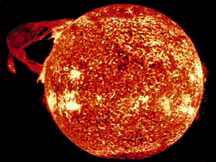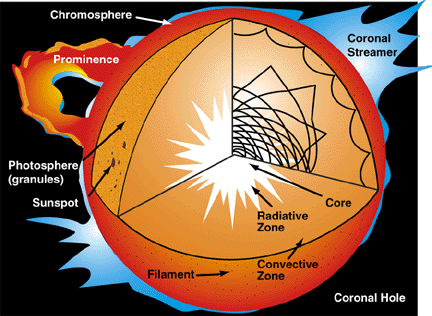What
in the world is a solar model?
 Over
time, many changes have been made to our understanding of
the sun. In the past 25 years, scientists have calculated
a model of it, using information from current technology.
They call it the Standard Solar Model. Over
time, many changes have been made to our understanding of
the sun. In the past 25 years, scientists have calculated
a model of it, using information from current technology.
They call it the Standard Solar Model.
 The
Standard Solar Model predicts that the sun consists of a core
that is surrounded by three layers. These layers include the
radiative layer, the convective layer, and the photosphere.
The sun's core has half of the sun's mass. That means that
the center of the sun is packed very tight. This is where
nuclear fusion occurs. It has been calculated that it takes
14,000 million years for one proton to fuse with another.
The core produces x-ray photons that work their way to the
surface of the sun through the radiative zone. This layer
is packed with hot gases and electrons called plasma. Currents
then carry the sun's energy to the surface in the convective
layer. The surface or photosphere (light ball) is the bright
surface of the sun. This is the area of the sun that early
scientists focused most of their attention. The granular surface
of the sun contains sunspots that come and go in a regular
eleven-year pattern. The lower atmosphere of the sun is called
the chromosphere (color ball). Because it emits very little
light, early scientists did not study it. Today, astronomers
find many interesting features including loops of hydrogen
gas called prominences in the chromosphere. The corona (crown)
is the outermost layer of the sun and is the most mysterious
layer of all. It can only be seen during a total solar eclipse. The
Standard Solar Model predicts that the sun consists of a core
that is surrounded by three layers. These layers include the
radiative layer, the convective layer, and the photosphere.
The sun's core has half of the sun's mass. That means that
the center of the sun is packed very tight. This is where
nuclear fusion occurs. It has been calculated that it takes
14,000 million years for one proton to fuse with another.
The core produces x-ray photons that work their way to the
surface of the sun through the radiative zone. This layer
is packed with hot gases and electrons called plasma. Currents
then carry the sun's energy to the surface in the convective
layer. The surface or photosphere (light ball) is the bright
surface of the sun. This is the area of the sun that early
scientists focused most of their attention. The granular surface
of the sun contains sunspots that come and go in a regular
eleven-year pattern. The lower atmosphere of the sun is called
the chromosphere (color ball). Because it emits very little
light, early scientists did not study it. Today, astronomers
find many interesting features including loops of hydrogen
gas called prominences in the chromosphere. The corona (crown)
is the outermost layer of the sun and is the most mysterious
layer of all. It can only be seen during a total solar eclipse.
|
